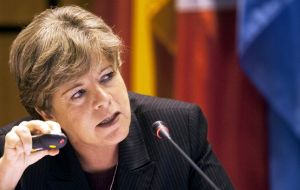MercoPress. South Atlantic News Agency
Pacific Alliance and Mercosur represent 90% of Latam and Caribbean GDP
 “The gradual convergence between the Pacific Alliance and Mercosur” is a natural conclusion of the integration, said Alicia Barcena
“The gradual convergence between the Pacific Alliance and Mercosur” is a natural conclusion of the integration, said Alicia Barcena  However globally in trade terms the region has been stagnant, in the range of 5% to 6% despite the strong prices for commodities
However globally in trade terms the region has been stagnant, in the range of 5% to 6% despite the strong prices for commodities The Pacific Alliance (PA) and the Common Market of the South (Mercosur) combined represent more than 80% of regional foreign trade as well as population, and more than 90% of GDP and direct foreign investment flows, according to a new report by the Economic Commission for Latin America and the Caribbean (ECLAC).
“The Pacific Alliance and Mercosur: towards convergence in diversity” was ECLAC's contribution to the seminar “Dialogue on Regional Integration: The Pacific Alliance and Mercosur” which took place in Santiago organized by the Chilean Ministry of Foreign Relations.
The report stresses that the two groups account for the seven biggest economies of Latin America and the Caribbean, according to 2013 GDP: Brazil, Mexico, Argentina, Colombia, Venezuela, Chile and Peru. The Pacific Alliance is made up of Chile, Colombia, Mexico and Peru, while Mercosur, Argentina, Brazil, Paraguay, Uruguay and Venezuela.
In 2013, total trade between both groups of countries reached 47.4 billion dollars, with exports from the Alliance to Mercosur totaling 23.7bn dollars and a similar figure on the other way.
Given the current exchange levels, Eclac argues that convergence between the Alliance and Mercosur not only will bring benefits to their member states, but also will be an historic opportunity to move towards true regional integration.
“An integration process of regional features seems more appropriate as a sign of the times and the demands of structural change in favor of equality in Latin America. The gradual convergence between the Pacific Alliance and Mercosur could prove to be a decisive catalyst of that process,” Alicia Barcena, Eclac's Executive Secretary, said at the study's introduction.
However globally Latin America and the Caribbean have shown a stagnant situation in terms of exports since the end of the nineties, considering that the region's participation in world exports has fluctuated between 5% and the current 6%, despite the high prices registered by some of the commodities exported by the region during most of the last decade.
Likewise the region has shown low incorporation in the knowledge-based economy, assigning just 0.84% on average of regional GDP between 2005 and 2012 to research and development (R&D), although investment in this field in most countries of the region (with the exception of Argentina and Brazil) was below 0.5% of GDP.
According to the United Nations organization, a final integration of all Latin American and Caribbean sub-regions should be the goal for the different groups and forums in the next years. Furthermore, concerted regional action would strengthen the region's voice in the world's principal debate arenas as well as relations with other key players in the international system.




Top Comments
Disclaimer & comment rules-

-

-

Read all commentsThe PA should keep well clear of the arseholes in Mercosur.
Nov 26th, 2014 - 10:15 am 0It will only end in tears for them if they do not.
And so begin the new history of South America ...
Nov 26th, 2014 - 10:27 am 0Before the end of the first half of this century South America will be a single federated country. It will be the largest country in area, and possibly one of the most prosperous and richest in the world.
Viva la Patria Grande!
Yeaaaaaah no it won't.
Nov 26th, 2014 - 11:13 am 035 years! Mercosur has been around for nearly that long and hasn't amounted to much at all.
And if you think that South America will move beyond idiotic movements like Chavismo and Peronism and get a standard of living and infrastructure equivalent to the EU then you are more uneducated than you have come across up till now.
Commenting for this story is now closed.
If you have a Facebook account, become a fan and comment on our Facebook Page!